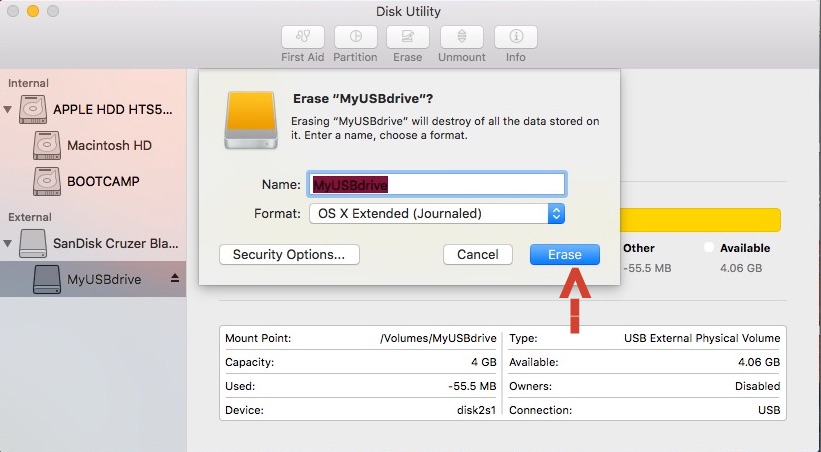

- #HOW TO FORMAT SD CARD ON MACBOOK PRO HOW TO#
- #HOW TO FORMAT SD CARD ON MACBOOK PRO DRIVERS#
- #HOW TO FORMAT SD CARD ON MACBOOK PRO PATCH#
- #HOW TO FORMAT SD CARD ON MACBOOK PRO SOFTWARE#
- #HOW TO FORMAT SD CARD ON MACBOOK PRO FREE#

If not, connect a USB card reader to your Mac, and insert the card into that. If your Mac has an SD card slot, insert the card. Most of us don’t take such precautions, however, so launch Setapp, search for Disk Drill and click Install. That’s because it has two features, Recovery Vault and Guaranteed Recovery that make it much more likely you’ll be able to recover data when it's deleted. It’s best if you have Disk Drill installed before you lose data, as a precaution. The good news is that Disk can scan a memory card and recover files in the most common situations when SD card data get lost. When your SD card is corrupted or damaged, your data will usually become inaccessible. Here’s a guide on how you can get your data back: The easy way to restore lost files on an SD card
#HOW TO FORMAT SD CARD ON MACBOOK PRO HOW TO#
How to do SD card recoveryĭisk Drill can scan a memory card and recover files in the most common situations when SD card data get lost. Check the article about the best ways to recover deleted files on Mac. Once you know your prediction is true and you can’t just restore data, roll up your sleeves and start the process of memory card recovery.
#HOW TO FORMAT SD CARD ON MACBOOK PRO DRIVERS#
Apart from that, you can try to reinstall the drivers or change the drive letter. The easiest would be to check your SD card on another device-obviously, a corrupted card won’t work on any computer. What if you can’t restore dataįirst of all, are you sure your card has been corrupted? There are at least three ways to check it. You can restore your files, but you need a special program for this. So, stop using it as soon as you realize there’s a problem. The more you use the card, the more chance there is your data will be over-written and you won’t be able to recover it.

If you stop using the card immediately, the data won’t be over-written, but if you continue to use the card, there’s a good chance it will be wiped completely. That’s because most cameras don’t wipe data completely – they only alter the file structure to make space available for new data. Before you begin to recover data The most important thing to be aware of is that you should stop using the SD card as soon as you realize you’ve deleted data or that it has become corrupt. Take a deep breath and follow the guide below to get your data back.
#HOW TO FORMAT SD CARD ON MACBOOK PRO SOFTWARE#
With reliable data recovery software and a backup, there’s nothing to worry about, though. If you see an error message when trying to access your SD card, it’s a warning sign.
#HOW TO FORMAT SD CARD ON MACBOOK PRO FREE#
NOTE: If the above steps do NOT resolve the problem, please back up your data and request a replacement using our online web form.Try free ✕ How to recover deleted files from an SD card
#HOW TO FORMAT SD CARD ON MACBOOK PRO PATCH#
Some older operating systems must have a patch installed before they can use the exFAT file system. NOTE: MacOS 10.6.2 or higher is required for exFAT file system. NOTE: exFAT can be used on flash drives or memory cards to transfer files larger than 4GB. NOTE: exFAT is used on SDXC card (64GB and higher). When finished, the drive will be formatted and repartitioned successfully. Choose Master Boot Record for the Schemeĥ.Choose exFAT or MS-DOS (FAT) for the format.Choose how you would like to format the drive Select the upper level of the drive you would like to format and click the Erase buttonĤ. In the top menu bar, go to View, and choose Show All Devicesģ. Please See Answer 20985: How to access Disk Utility macOSĢ. Instructions below are for 10.13.x (High Sierra)ġ. Select this capacity.Ħ. Verify Volume Format is set to MS-DOS file system or exFAT, Scheme is set to “Master Boot Record” ( Do NOT select GUID Partition Map) then click Erase. Select the capacity of the drive respective to the one containing the device you wish to format then click the Erase tab.Įxample: If the drive is called "NO NAME", directly above that, you should see the drive capacity of "XXXX". On the left side of the window are the drives connected to the computer. Click the Applications folder - if using a Finder Window Applications will be in the left side menu.ĥ. Double-click on Macintosh HD - or in the Finder menu click File > New Finder WindowĢ. Instructions below are for 10.11.x (El Capitan) and 10.12.x (Sierra)ġ. WARNING: Formatting will erase all data on the device.


 0 kommentar(er)
0 kommentar(er)
